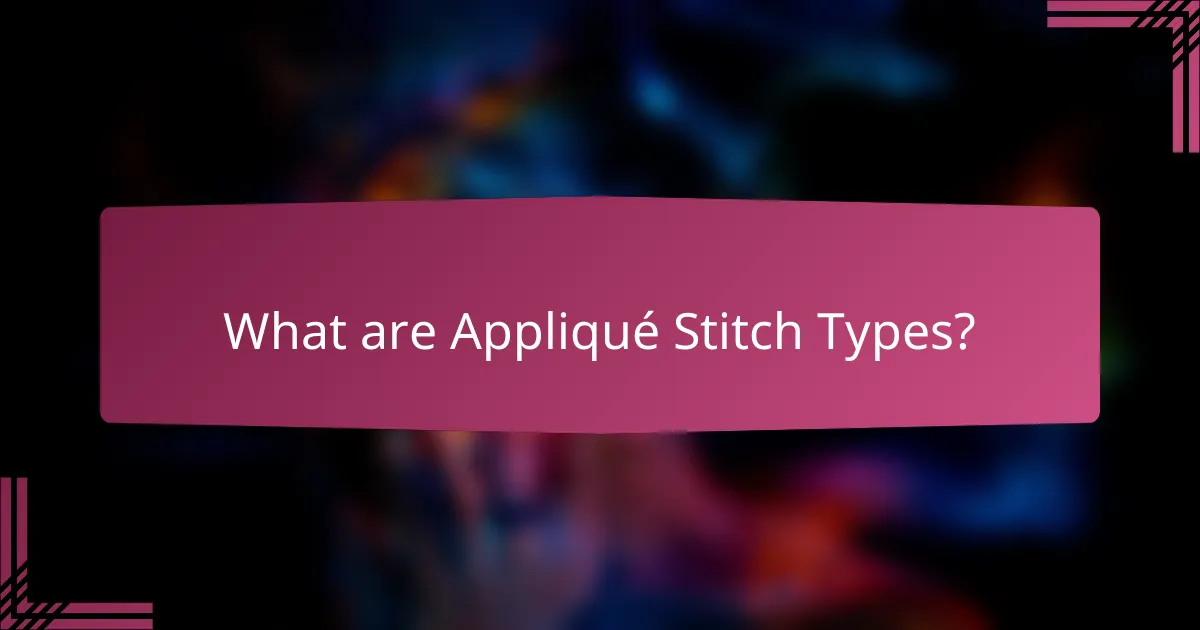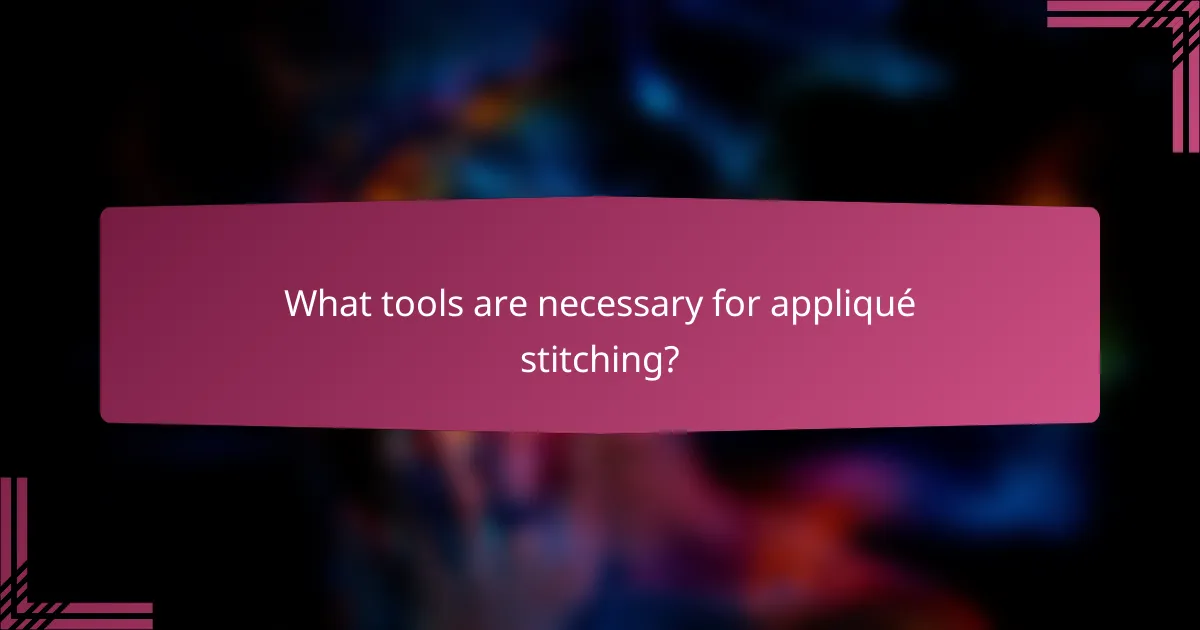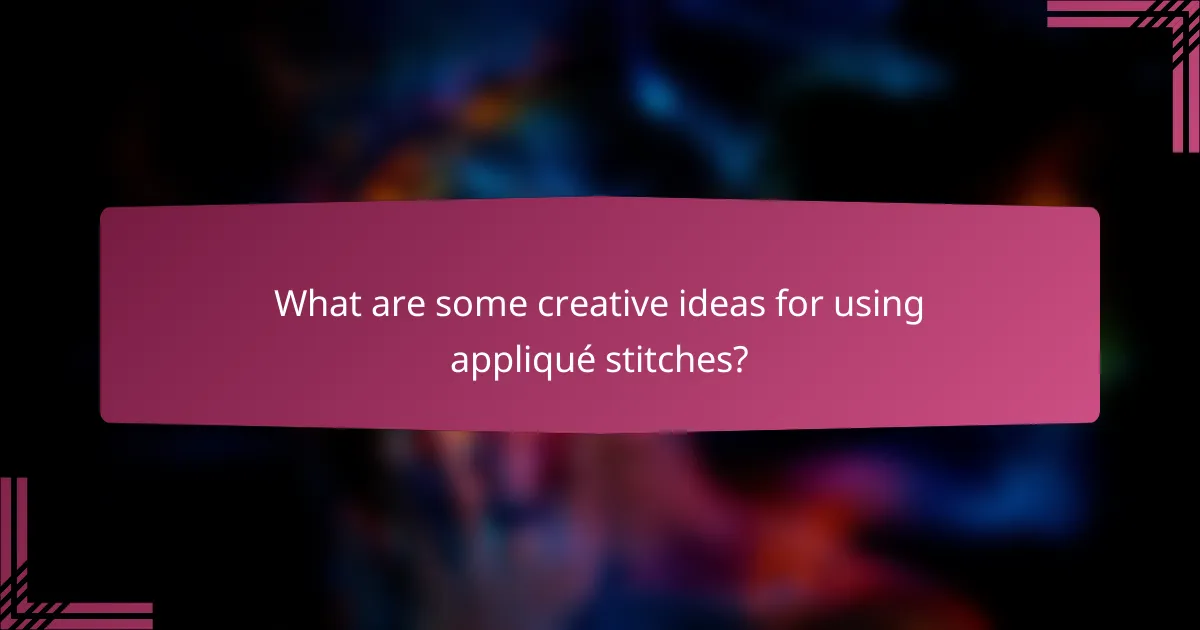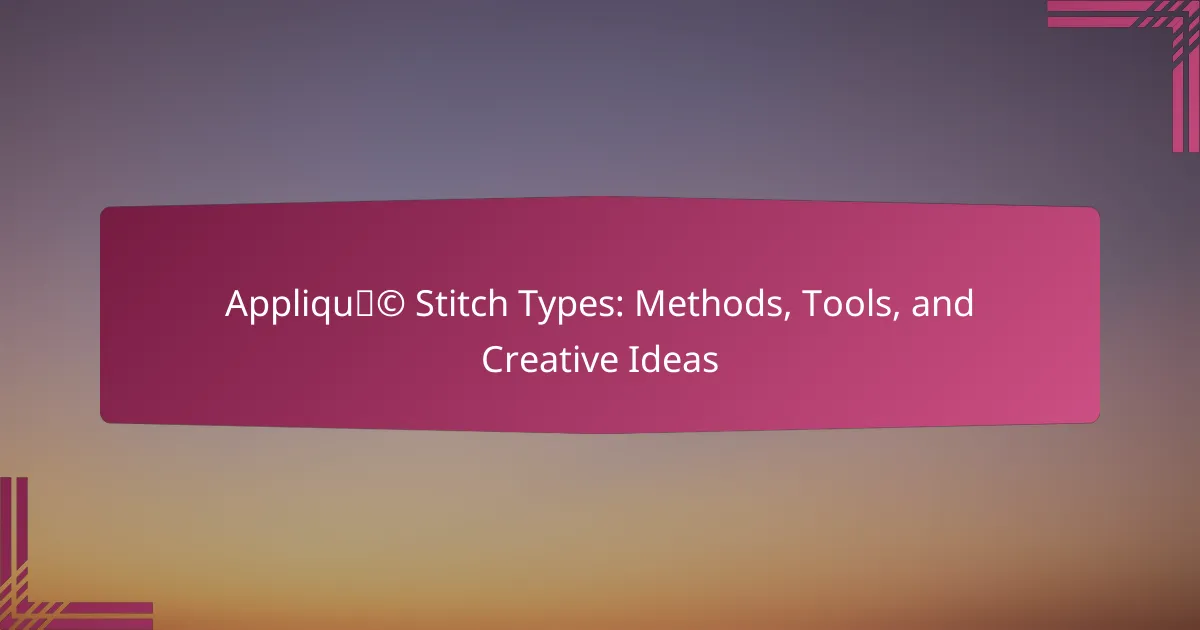
What are Appliqué Stitch Types?
Appliqué stitch types are specific sewing techniques used to attach one fabric onto another. Common types include zigzag stitch, straight stitch, and blanket stitch. Zigzag stitch provides a decorative edge while securing the appliqué. Straight stitch offers a clean, minimalistic finish. Blanket stitch is often used for a more textured look, ideal for thicker fabrics. Each stitch type serves different aesthetic and functional purposes in appliqué projects. Understanding these types enhances creativity in fabric art and garment making.
How do different appliqué stitch types vary in technique?
Different appliqué stitch types vary in technique based on their application and visual effect. The straight stitch is commonly used for basic appliqué, providing a clean edge. The zigzag stitch offers more flexibility, allowing for curves and intricate designs. The blind stitch is nearly invisible on the front, ideal for delicate fabrics. The satin stitch creates a dense, decorative finish, suitable for bold designs. Each stitch type requires specific tension settings and fabric handling techniques. For example, the zigzag stitch may need a wider width for thicker fabrics. The choice of stitch impacts the durability and aesthetic of the appliqué work.
What are the key characteristics of basic appliqué stitches?
Basic appliqué stitches are characterized by their ability to attach fabric pieces to a base fabric. These stitches include straight, zigzag, and satin stitches. Straight stitches provide a simple, clean finish. Zigzag stitches allow for more flexibility and can accommodate various fabric types. Satin stitches create a dense, decorative edge. Each stitch type can be adjusted for width and length. Basic appliqué stitches are commonly used in quilting and garment making. They enhance the design while securing the appliqué piece effectively.
How do decorative appliqué stitches enhance designs?
Decorative appliqué stitches enhance designs by adding texture and visual interest. These stitches create intricate patterns that elevate the overall aesthetic. They can transform simple fabric into a work of art. Various stitch types, such as zigzag and satin stitches, provide different effects. Decorative stitches can also highlight specific areas of a design. This technique allows for personalization and creativity in projects. The use of color and stitch variation can create depth. Overall, decorative appliqué stitches contribute significantly to the uniqueness of textile designs.
Why is it important to choose the right appliqué stitch type?
Choosing the right appliqué stitch type is crucial for achieving the desired aesthetic and durability in fabric projects. Different stitch types affect the final appearance, texture, and longevity of the appliqué. For instance, a zigzag stitch provides a decorative edge while securing the fabric, making it suitable for raw-edge appliqué. In contrast, a straight stitch offers a clean finish ideal for turned-edge appliqué, ensuring that the edges are neatly tucked under. The appropriate stitch type also influences how well the appliqué withstands washing and wear. Selecting the wrong stitch can lead to fraying or detachment over time. Therefore, understanding the characteristics of each stitch type is essential for successful appliqué work.
What factors should influence the selection of an appliqué stitch?
The selection of an appliqué stitch should be influenced by the fabric type, design complexity, and desired durability. Fabric type affects stitch choice; lighter fabrics may require finer stitches while heavier fabrics can accommodate thicker stitches. Design complexity dictates the stitch’s visibility; intricate designs benefit from decorative stitches, while simpler ones may use basic stitches for a clean look. Desired durability is crucial; functional appliqués need robust stitches to withstand wear, while decorative ones may prioritize aesthetics over strength. The combination of these factors ensures the appliqué is both visually appealing and appropriate for its intended use.
How does the fabric type affect the choice of appliqué stitch?
The fabric type significantly influences the choice of appliqué stitch. Different fabrics have varying thicknesses, textures, and stretch characteristics. For instance, lightweight fabrics like silk require finer stitches to prevent puckering. In contrast, heavier fabrics such as denim can accommodate thicker, more robust stitches. Stretch fabrics necessitate the use of a stretch stitch to maintain elasticity. The choice of stitch also depends on the fabric’s weave; tightly woven fabrics may require sharper needles and more precise stitches. Additionally, fabric fray levels dictate whether a zigzag stitch or a straight stitch is more appropriate. These considerations ensure durability and aesthetic appeal in the final appliqué design.

What tools are necessary for appliqué stitching?
The necessary tools for appliqué stitching include fabric scissors, pins, and a sewing machine. Fabric scissors are essential for accurately cutting out appliqué shapes. Pins help secure the appliqué pieces to the base fabric during stitching. A sewing machine facilitates the stitching process, allowing for a variety of appliqué techniques. Additionally, a rotary cutter and mat can enhance cutting precision. Using these tools ensures clean edges and effective application of appliqué designs.
Which essential tools do you need for appliqué stitching?
You need a few essential tools for appliqué stitching. These include fabric scissors for precise cutting of shapes. A rotary cutter can also be helpful for straight edges. A cutting mat provides a safe surface for cutting. You will need an iron to press the fabric for smoothness. Fusible webbing helps adhere appliqué pieces to the base fabric. A needle and thread suitable for the fabric are crucial for stitching. Finally, pins or clips hold the appliqué in place while working. Each tool enhances the efficiency and quality of the appliqué process.
What role do scissors and rotary cutters play in the process?
Scissors and rotary cutters are essential tools in the appliqué process. Scissors provide precision for detailed cutting of fabric shapes. They allow for intricate designs and curves that enhance the final outcome. Rotary cutters, on the other hand, are ideal for cutting multiple layers of fabric quickly. They ensure straight, clean edges, which is crucial for achieving professional-looking appliqué. Both tools contribute to efficiency and accuracy, reducing the likelihood of fraying or uneven edges. Their roles are fundamental in preparing fabric pieces for appliqué stitching.
How do different types of threads impact the final outcome?
Different types of threads significantly impact the final outcome of appliqué projects. The choice of thread affects the appearance, durability, and texture of the finished piece. For instance, cotton threads provide a matte finish and are ideal for lightweight fabrics. Polyester threads offer strength and shine, making them suitable for high-stress areas. Specialty threads, like metallic or variegated, add visual interest and dimension. The thread weight also influences the stitch definition; heavier threads create bold outlines, while lighter threads allow for more delicate details. Overall, the right thread enhances the aesthetic and functional qualities of the appliqué work.
What advanced tools can enhance your appliqué projects?
Advanced tools that can enhance your appliqué projects include embroidery machines, heat transfer tools, and specialized cutting machines. Embroidery machines allow for precise stitching and intricate designs. They often come with built-in patterns and customizable options. Heat transfer tools, such as irons and heat presses, help secure appliqué pieces effectively. These tools ensure a smooth finish and prevent fraying. Specialized cutting machines, like Cricut or Silhouette, can cut fabric shapes accurately and quickly. These machines save time and provide consistent results. Each of these tools contributes to higher quality and more professional-looking appliqué projects.
How can specialty feet for sewing machines improve appliqué work?
Specialty feet for sewing machines can significantly enhance appliqué work. They provide precise control over fabric movement. This control allows for cleaner, more accurate stitching around intricate shapes. Specialty feet, such as the open-toe foot, improve visibility of the stitching line. A clear view helps in maintaining alignment with the fabric edges. Additionally, walking feet prevent layers from shifting during sewing. This feature ensures consistent stitching, even on multiple fabric layers. Ultimately, these tools lead to a more professional finish in appliqué projects.
What are the benefits of using fabric stabilizers in appliqué?
Fabric stabilizers provide essential support in appliqué. They prevent fabric distortion during stitching. Stabilizers enhance the overall stitch quality. They help maintain the shape of intricate designs. Using stabilizers reduces puckering and fraying. They also improve the durability of the finished piece. Different types of stabilizers cater to various fabric weights and types. For example, tear-away stabilizers are effective for lightweight fabrics. This adaptability makes them versatile for diverse appliqué projects.

What are some creative ideas for using appliqué stitches?
Appliqué stitches can be creatively used in various textile projects. One idea is to embellish clothing with unique designs. This can transform plain garments into personalized fashion statements. Another application is creating decorative quilts. Appliqué can add depth and texture to quilt blocks.
You can also use appliqué on home decor items. This includes pillows, table runners, and wall hangings. Adding appliqué to these items enhances their visual appeal. Additionally, you can incorporate appliqué in craft projects. Items like tote bags and hats can showcase intricate designs.
Using contrasting fabrics for appliqué can create striking visual effects. Layering different fabrics adds dimension to the design. Furthermore, you can experiment with various stitch types. Techniques like zigzag or satin stitches can enhance the finished look.
Finally, seasonal decorations can benefit from appliqué. Holiday-themed items, such as ornaments, can be made more festive. These creative ideas illustrate the versatility of appliqué stitches in textile art.
How can you incorporate appliqué stitches into various projects?
You can incorporate appliqué stitches into various projects by using them to attach fabric shapes to a base material. This technique enhances the visual appeal of items like quilts, clothing, and home décor. Start by selecting your fabric shapes and the base fabric. Then, choose an appropriate appliqué stitch, such as zigzag or satin stitch, to secure the shapes. Use a fabric adhesive for initial placement to prevent shifting. Finally, sew around the edges of the shapes to finish the appliqué. This method allows for creativity in design and personalization of projects.
What types of items can be enhanced with appliqué techniques?
Appliqué techniques can enhance various textile items. Common items include clothing, such as shirts and jackets. Home décor items, like cushions and wall hangings, can also be enhanced. Accessories, such as bags and hats, benefit from appliqué designs. Quilts often incorporate appliqué for added visual interest. Table linens, including napkins and tablecloths, can showcase appliqué techniques. Children’s items, such as blankets and toys, frequently use appliqué for decoration. These applications demonstrate the versatility of appliqué in textile arts.
How can you use appliqué stitches to personalize gifts?
You can use appliqué stitches to personalize gifts by adding unique designs or initials to fabric items. Choose a fabric that contrasts with the base material for visibility. Cut out shapes or letters from the chosen fabric. Secure the appliqué with pins or fabric glue before stitching. Use a zigzag or straight stitch around the edges for durability. This technique allows for customization of items like bags, quilts, or clothing. Personalized gifts with appliqué can convey thoughtfulness and creativity. Many crafters report increased satisfaction from creating personalized items using this method.
What are some tips for mastering appliqué stitching?
To master appliqué stitching, practice is essential. Start with simple shapes to build confidence. Use high-quality fabric to achieve better results. A sharp needle and appropriate thread enhance precision. Stabilizers can prevent fabric from shifting during stitching. Experiment with different stitch types to find your preferred style. Consistent tension while sewing ensures neat edges. Lastly, take your time and enjoy the creative process.
How can you avoid common mistakes in appliqué stitching?
To avoid common mistakes in appliqué stitching, ensure proper fabric preparation. Pre-wash and iron fabrics to eliminate shrinkage and wrinkles. Use a stable base fabric to support the appliqué. Choose the right needle and thread for your fabric type. Maintain consistent stitch length for a uniform look. Avoid pulling the fabric too tight while stitching. Secure edges with a suitable stitch to prevent fraying. Finally, practice on scrap fabric to refine your technique before starting on the final piece.
What best practices should you follow for successful appliqué projects?
Use high-quality fabrics for appliqué projects. Quality fabrics enhance durability and appearance. Pre-wash fabrics to prevent shrinkage later. Choose appropriate stabilizers to support the fabric during stitching. Use a sharp needle to avoid fabric damage. Select the right thread type for the fabric. Practice stitching techniques on scrap fabric before starting the project. Plan the design layout carefully to ensure proper placement.
Appliqué stitch types are sewing techniques used to attach one fabric onto another, including zigzag, straight, and blanket stitches, each serving distinct aesthetic and functional purposes. The article explores the variations in techniques, key characteristics of basic and decorative stitches, and the importance of selecting the appropriate stitch type based on fabric and design. It also discusses essential and advanced tools for appliqué stitching, factors influencing stitch selection, and creative ideas for incorporating appliqué into various projects. Additionally, best practices for mastering appliqué stitching and avoiding common mistakes are provided to enhance the quality and personalization of textile art.
